NORTH SAILS BLOG
Tutto
Events
Guides
News
People
Podcast
Sustainability
Tech & Innovation
Travel & Adventure
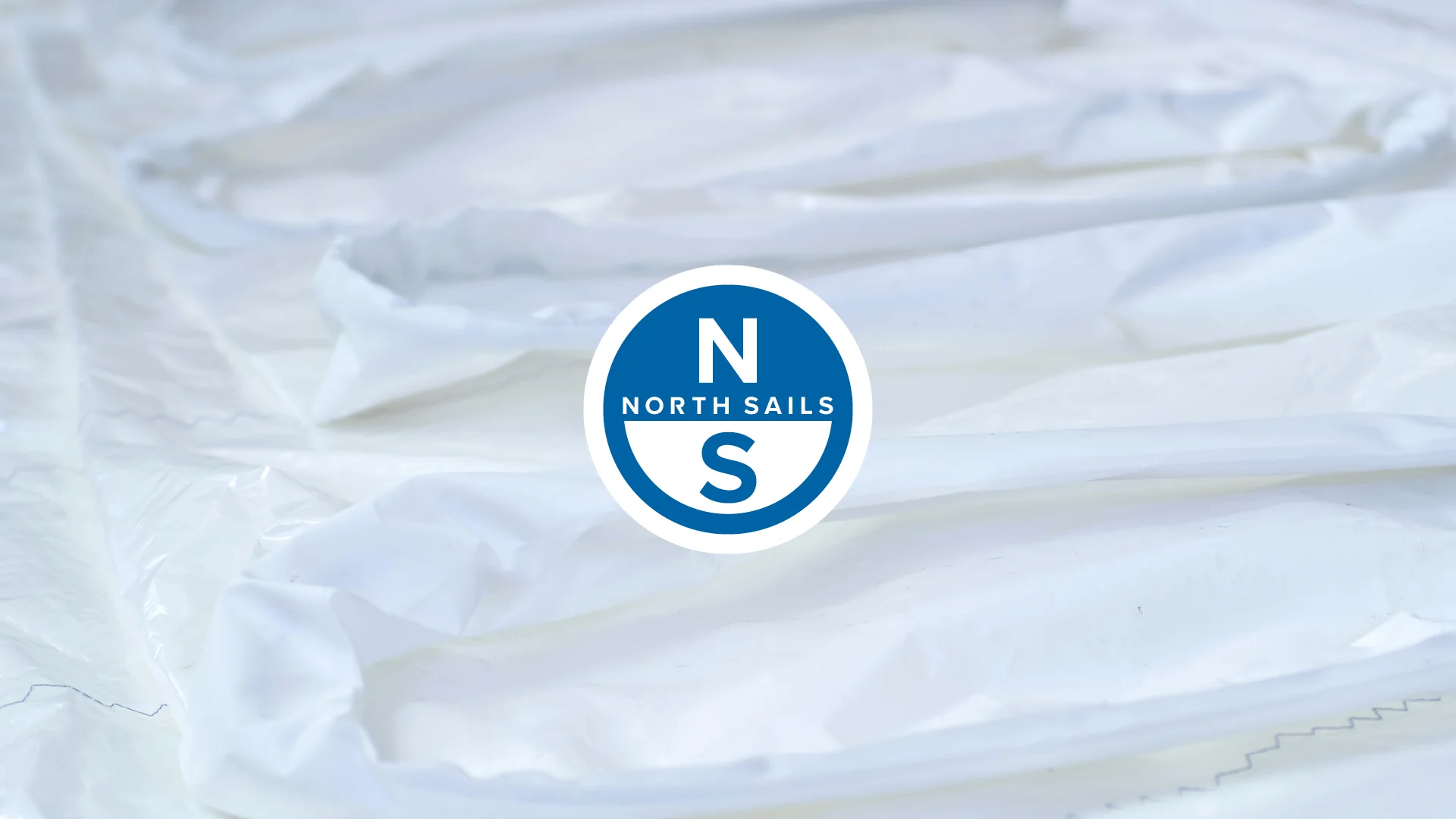
OPTIMIST TUNING GUIDE
V-Series Important Settings for Key Performance
Power your new North Sails Optimist V-Series mainsail for speed following the recommendations on this quick tuning guide.
BASE SETTINGS
Sail ties can be adjusted in the range of 1-5mm in light wind and heavy wind to have comfortable depth and shape.
LIGHT WIND: Smaller space at the middle so that leech becomes easier open.
HEAVY WIND: Smaller space at the middle so that you can make the shape comfortably flat enough to reduce the power.
Sail Ties:
Top: 2mm
Middle: 2mm
Bottom: 2mm
* Parallel to the mast.
Distance of space distribution to be made from top to the bottom.
Adjustment is required only for suitable sail shape (depth) for each condition and to be done only when needed.These are sometimes required depending on mast stiffness and sailor’s weight, but only when if needed.
BASIC TRIM
Wind Range
0-8 knots
8-12 knots
12-16 knots
Mast Rake
2780 – 2800 mm
2770 – 2790 mm
2770 – 2780 mm
Sprit
Wrinkles
Some Wrinkles
A Few Wrinkles
Vang
No tension in upwind
Light tension in upwind
Tension
Prebender
2 turns /Some Slack at Luff
2 turns /Some Slack at Luff
No Wrinkle at Luff
Center Board
Max
Max
Max
Wind Range
16-24 knots
25+ knots
Mast Rake
2750 – 2760mm
2790 ±10mm
Sprit
Wrinkles
Wrinkles
Vang
Lots of tension
Cleat with main sheet trimming harder
Prebender
Tension on Luff
Tension on Luff
Center Board
0-50 mm up
30-70 mm up
OUTHAUL CONTROL – VERY IMPORTANT FOR KEY PERFORMANCE!
You have to pay attention to the outhaul to adjust it properly according to the conditions and sailors weight.
You need to find the best position that fits your weight, mast rake( boom position), sea status, weather helm feeling for each condition.
Playing outhaul in the range of 20mm at the boom end.
Ease it maximum in 10-14knots and clew end has to be located 30-40mm away from the boom end.
FLAT WATER – Trim 10mm more than the normal position.
LIGHT / VERY STRONG WIND – Bottom to be flattened comfortably.
READ MORE
READ MORE
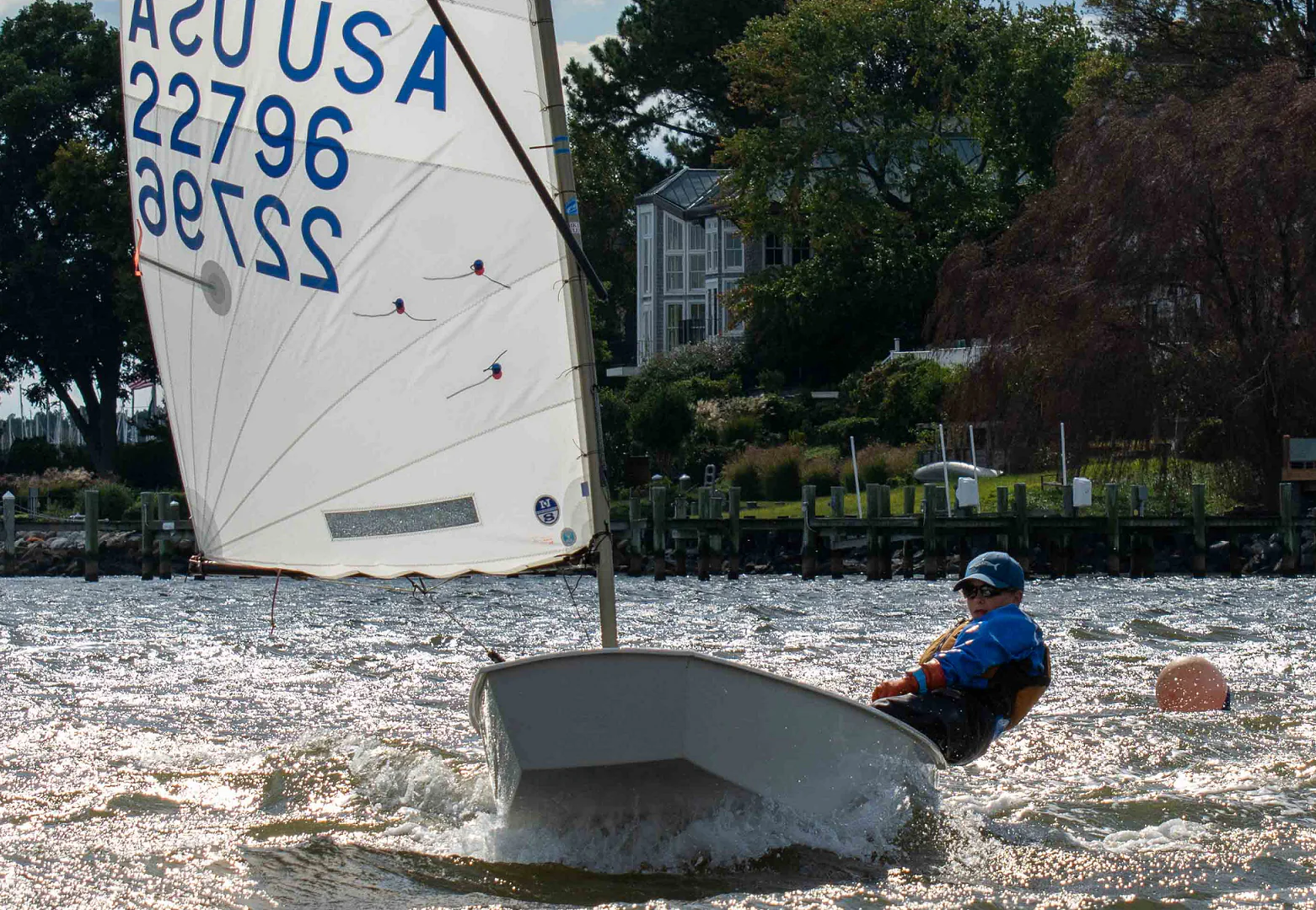
NEW OPTIMIST V-SERIES TUNING TABLE
OPTIMIST V-SERIES QUICK TUNING TABLE
Important Settings for Key Performance
Power your new North Sails Optimist V-Series mainsail for speed following the recommendations on this quick tuning guide.
BASE SETTINGS
Sail ties can be adjusted in the range of 1-5mm in light wind and heavy wind to have comfortable depth and shape.
LIGHT WIND: Smaller space at the middle so that leech becomes easier open.
HEAVY WIND: Wider space at the middle so that you can make the shape comfortably flat enough to reduce the power.
Sail Ties
Top
2 mm
Middle
2 mm
Bottom
2 mm
* Parallel to the mast.
Distance of space distribution to be made from top to the bottom.
Adjustment is required only for suitable sail shape (depth) for each condition and to be done only when needed.
These are sometimes required depending on mast stiffness and sailor’s weight, but only when if needed.
BASIC TRIM
Wind Range
0-8 knots
8-12 knots
12-16 knots
16-24 knots
25+ knots
Mast Rake
2780 – 2800 mm
2770 – 2790 mm
2770 – 2780 mm
2750 – 2760mm
2790±10mm
Sprit
Wrinkles
Some Wrinkles
A Few Wrinkles
Wrinkles
Wrinkles
Vang
No tension in upwind
Light tension in upwind
Tension
Lots of tension
Cleat with main sheet trimming harder
Prebender
2 turns /
Some Slack at Luff
2 turns /
Some Slack at Luff
No Wrinkle at Luff
Tension on Luff
Tension on Luff
Center Board
Max
Max
Max
0-50 mm up
30-70 mm up
OUTHAUL CONTROL – VERY IMPORTANT FOR KEY PERFORMANCE!
You have to pay attention to the outhaul to adjust it properly according to the conditions and sailors weight.
You need to find the best position that fits your weight, mast rake( boom position), sea status, weather helm feeling for each condition.
Playing outhaul in the range of 20mm at the boom end.
Ease it maximum in 10-14knots and clew end has to be located 30-40mm away from the boom end.
FLAT WATER – Trim 10mm more than the normal position.
LIGHT / VERY STRONG WIND – Bottom to be flattened comfortably.
READ MORE
READ MORE
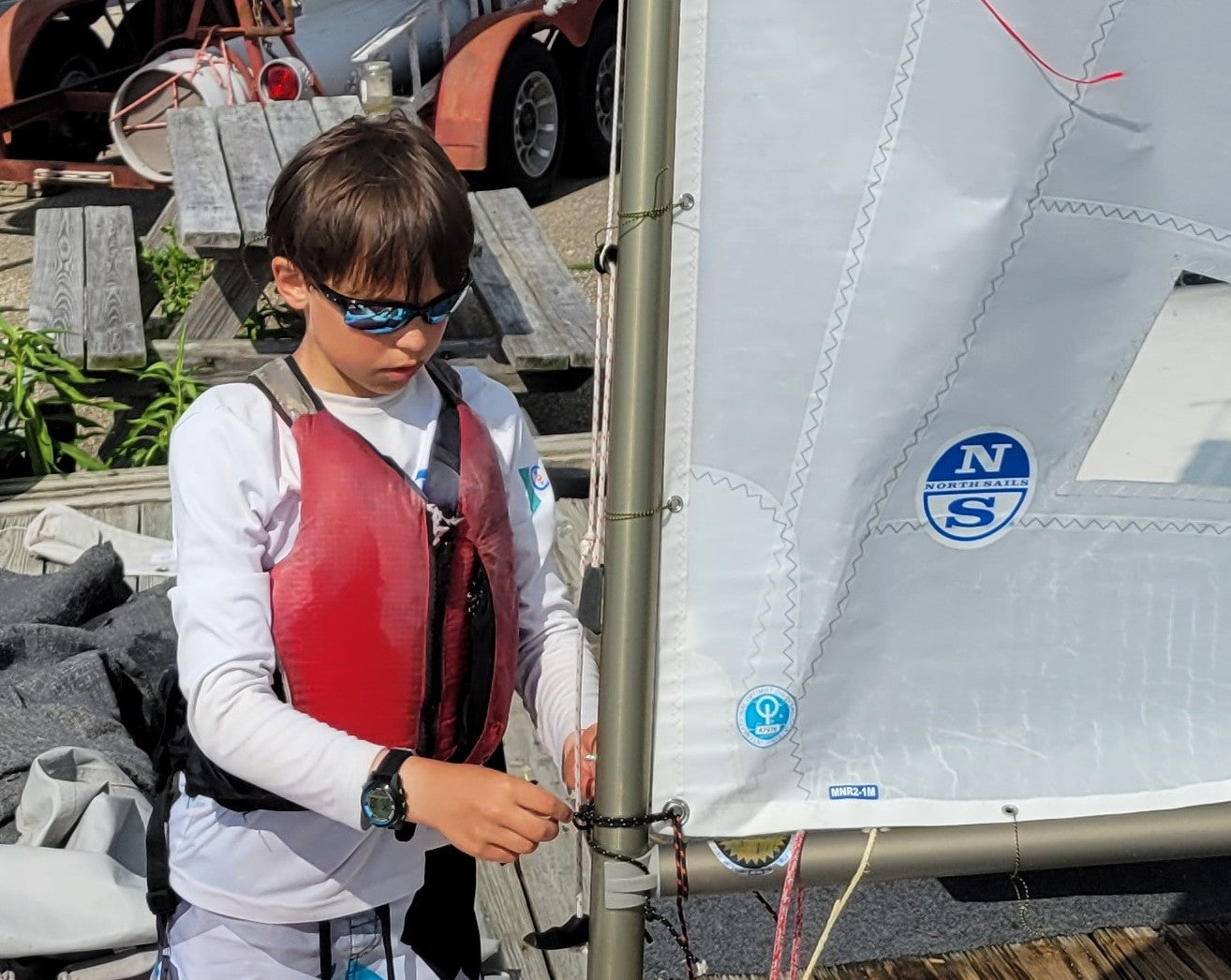
OPTIMIST NATIONALS REPORT
2021 OPTIMIST NATIONALS REPORT
The Scoop on the New V-Series
by Tom Sitzmann
The 2021 Nationals had very light and unstable winds and only 7 races were completed over four days. Sailor Annie Sitzmann used the new North V-2 brand new from Japan. She was the only sailor at the event using the new sail, and despite the fact that she had zero testing time prior to the event, she took on the challenge and is getting better and better each day learning how to properly tune and rig her new sail.
I also worked with Ashton Perkins, who used a North MNR-2. Initially lining these two up, Ashton was higher for sure; the MNR entry is very straight/flat, Ashton is very small/light so he can get away with trimming a little tighter. As the event went on, we seemed to dial in the new V-2 sail. Annie even won a race, which shows that the sail can definitely perform even if in beginner’s hands. With more time on the water and testing, and also testing a few different spar sets, this sail looks very good and makes a great option for the North Sails Optimist inventory. Based on what we observed over the course of the event, I found the outhaul and vang to be extremely important for this sail, and am still learning proper rake and sprit combinations.
Optimist National Championship Report & Interview with Ashton Perkins
The Optimist class US National Championship was held this year in Norfolk, VA and the wind gods sure seemed to team up to confound the event. While the Girls National championship (a one-day event at the beginning of the week) had good winds, the four-day National championship event could only muster seven races total, and that included three on the last day just to get there. So, the event was left to be determined through qualifying rounds only, with no gold fleet races.
North Sails is very excited to announce our new Optimist sail, the V-Series. This sail reflects the culmination of a great deal of testing, hard work, and expertise by North Sails one-design experts and sail designers, and we are confident that this sail offers great speed, pointing ability upwind, and shape durability.
In hot, sticky weather, with so many variables, at times extremely light, shifty, unstable and unsettled winds, sailors were challenged to post any type of consistent scores. Young up-and-coming sailor Ashton Perkins used a North Optimist sail, and Ashton showed blazing speed upwind in this regatta. If it weren’t for a UFD penalty, Ashton would have posted his best-ever regatta finish in the top 10 overall! We caught up with him after the event to get his take on things.
First, congratulations on your performance at the US Optimist Nationals! This was a difficult event with very light unstable winds for sure, and you seemed very fast throughout the regatta. If not for your final day UFD you’d have been in the top ten out of 260 boats! Let’s get to know you. Where do you live, what grade are you going into this fall? How long have you been sailing? What do you like about sailboat racing?
A: I live in University Park Maryland and I am entering the 6th grade. I have been sailing for 6 years. Sailboat racing is great for me because I love thinking about strategy and being on the water.
In this regatta specifically, what was most challenging?
A: Catching the wind shifts.
What was most important? (current, shifts, starts, etc.)
A: They were all really important.
What worked well for you, and what are you most happy with?
A: Except for my U flag and one other start my starts were good. I played the big shifts and I was usually faster than most other boats.
What do you like about the North Optimist Sail?
A: I used to use a J Blue. With the North I am able to point higher while keeping the same speed.
What trimming advice do you have for anyone using this sail?
A: In light air trim just within the corner and in heavy air pull it in slightly tighter.
What’s next? Where will we see you again?
A: New Englands and New Jersey States. I am excited that I qualified for team trials, I also look forward to that this coming Spring 2022.
READ MORE
READ MORE
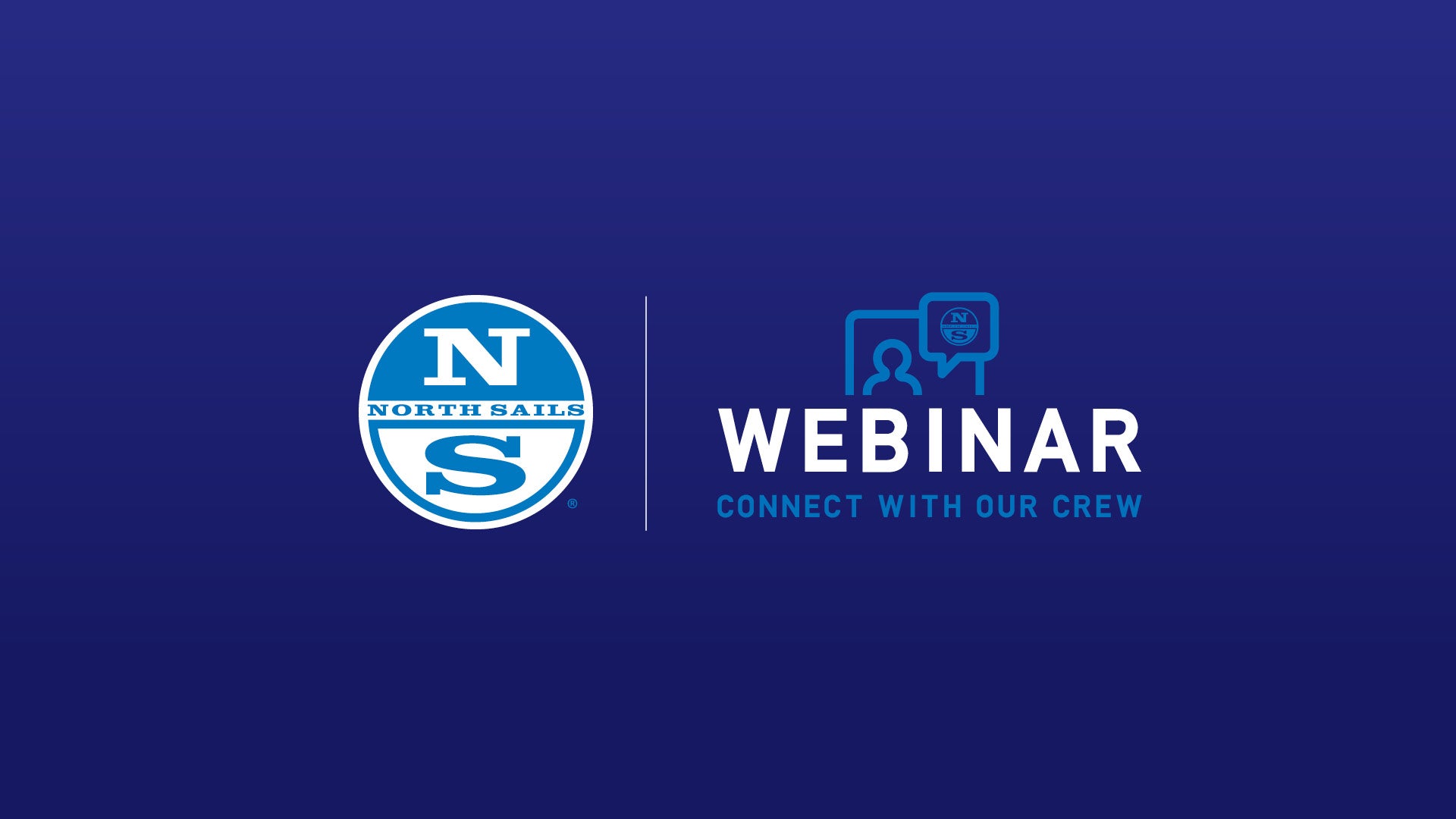
LET'S TALK OPTIMIST WITH ANDREW WILLS, DEREK SCOTT AND CHRIS STEELE
LET’S TALK OPTIMIST WITH ANDREW WILLS, DEREK SCOTT, AND CHRIS STEELE
Session One
Optimist class experts Andrew Wills and Derek Scott talk all things Optimist with special guest Chris Steele who won the Worlds in 2007 with Wills as a coach. This session covers planning, daily routine, race routine and how to maintain a good training mindset.
READ MORE
READ MORE
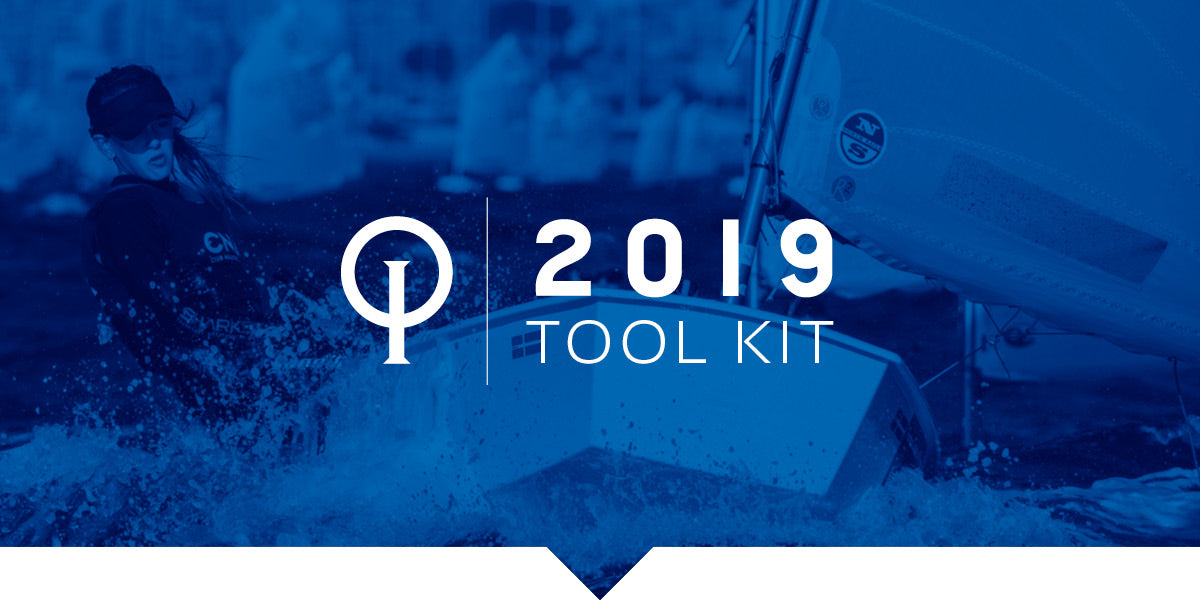
OPTIMIST WORLDS TOOL KIT
Get Ready For The Opti Worlds. There is no better performance test of an Optimist sail than the results it produces. Around the world, kids are winning regattas with North Sails.
READ MORE
READ MORE
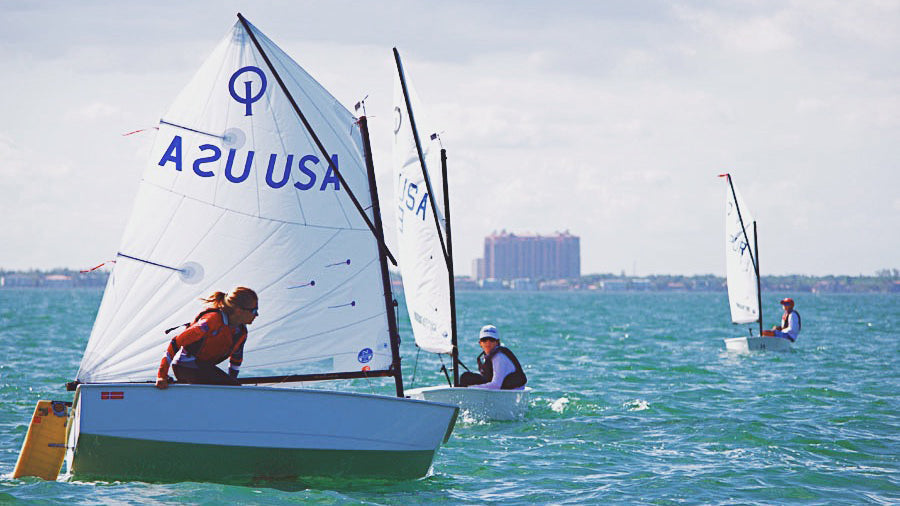
OPTIMIST DINGHY SPEED GUIDE
North Sails class leaders Zeke Horowitz and Juan Carlos Romero answer your International Optimist Dinghy speed and boathandling questions.
Who sails an Optimist Dinghy?
The pram-style Optimist is a great starter boat for learning to sail and later learning to race, and youth sailors can literally take their Optimist Dinghy to whatever level they want. Any motivated young Optimist sailor will develop both confidence and dinghy sailing skills, from boathandling techniques to big-fleet strategy and tactics; some will go on to race at the highest levels. The sailors who do best in the class are those who spend the most time sailing their boats, usually with a good coach, strong sailing program, and ample resources. The International Optimist Dinghy Association is the biggest one-design class in the world.
Top young Optimist sailors line up on the starting line at a clinic held on Miami's Biscayne Bay.
Who is the ideal Optimist sailor physically?
Sailors should be fit and agile, able to move gracefully and hike out for extended periods. Those who do best are usually 12 to 14 years old and weigh up to 110 pounds. Regionally, top sailors can still compete at 115 or even 120 pounds. Girls sail equally with boys, and it’s common to see three or four girls in the top 10 at any regatta.
What are three top Optimist speed tips?
Find a good coach and team.
Focus hard while you’re on the water.
Do well in school so you can miss days while off sailing.
What should buyers know when choosing an Optimist Dinghy?
Any sailor’s first boat is typically a used boat, to allow for collisions due to inexperience with dock landings and being in close quarters with other boats. Competitive sailors will normally move up to new boats as they reach higher levels. Older boats can remain competitive, but heavy travel and racing schedules put a fair amount of wear and tear on the boats. As a result, used boats may need gelcoat dings and scratches repaired. A fully outfitted new boat may run $5,500, while a good used boat costs 30 to 40 percent less. Keep in mind that you can purchase different sizes of boom section with different stiffness, although most sailors stick with a mid-range version. As a sailor grows, a stiffer boom may be preferred. If your mast is extremely bendy, it may also help to replace it with a stiffer one as experience and size merit.
How do you move an Optimist Dinghy around?
An Optimist weighs only 35 kilograms (77 pounds), which makes it easy to put on top of a car. There are also many trailering options; some teams own trailers that carry up to 18 boats, plus a coach boat!
How long does it take to rig an Optimist Dinghy?
Rigging time depends on how focused the sailor is on the task, but it’s not hard to have a boat ready in 40 minutes. What’s most time-consuming is attaching the sail to the spars, which in the Optimist requires tying knots in a way that’s carefully prescribed by the rules (see the North Sails Optimist Tuning Guide). The goal is to match the luff curve with how much the mast will bend in a given condition, which varies depending on a sailor’s weight.
How many sails are allowed?
Top sailors will take two sails to a regatta, but just one sail is allowed for the duration of the event; the other is a backup in case of a breakdown. There is some nuance to selecting Optimist sails, but North presents a good choice of radial or crosscut sails of different size depending on the sailor’s weight. Read more about what North offers, from a crossover sail for beginners, to two crosscut and four radial-cut racing sails.
International Optimist Dinghy Tuning
What are the keys to rig set-up?
Tuning the rig on a boat with an unstayed mast is different than on other boats. It starts before you attach the sail on the mast; first measure your mast rake—from the top of the mast to the edge of the coaming on the transom—and then move the adjustable mast step until you get the right rake measurement for your weight. This is your “base” setting. The process is detailed in the North Tuning Guide. The Tuning Guide also covers the critical process of tying the sail to the boom, mast, and sprit, and connecting the sprit correctly to the mast.
Properly eased outhaul tension shows wrinkles at each sail tie giving ample power to the lower part of the sail.
What control systems are unique to the Optimist?
Having a sprit pole, and a line to change the tension on it, is not the norm on most one-design racing boats. Sprit tension controls leech tension, but if you have too much, a wrinkle will appear between the tack and the peak of the sail. A sail that’s set right for upwind sailing often develops the same wrinkle when you turn downwind, so you’ll often need to ease the sprit tension at that point to get rid of the wrinkle. Preventers are another unusual concept on the Optimist. They are needed because of the way the sail, boom, and sprit are connected with the mast. The top preventer keeps the sail from popping off the top of the mast, and in heavy air, it can be tightened to force the sail to set lower on the mast. The lower preventer, called the boom preventer, maintains boom position on the mast and helps you set the right luff tension for the conditions. There are strict rules about how high or low the sail can be on the mast—a mark on the sail must fall between two marks on the mast to be legal.These controls are described in the Tuning Guide as well. We recommend the Guide to every new sailor and Opti parent.
A modest wrinkle from the top of the mast extending toward the end of the boom indicates correct sprit tension.
Optimist Dinghy Upwind Sailing
How do you trim the sail upwind in light air?
Here’s a checklist to run through if you’re sailing upwind in light enough air to be sitting in the boat. Set your mast rake a bit aft of your base setting, since your mast is probably not going to bend under this wind condition (see Tuning Guide). Ease the outhaul until any horizontal crease in the foot disappears and some vertical creases show up above each sail tie; the creases should not pass above the first seam in the sail. Luff tension should be eased enough that as you sail into a puff, horizontal wrinkles appear at the sail ties along the mast. To be sure you’re not closing the leech too much, ease the sprit pole just to the point that a wrinkle appears from the top of the mast to the clew. Focus on where to trim the boom relative to the corner of the transom—a good general rule is no farther inboard than the corner, or leave it just outside.
Shown sailing in a clinic (without sail numbers), these Optimist Dinghies show off the design’s distinct profile with sprit rig and squared off bow and stern.
When sailing in medium winds, how should the sail be trimmed upwind?
Move the mast rake back to your base setting when you move to the rail, and in choppy conditions, pull the outhaul tight enough so the vertical creases at the boom sail ties extend only up to the first seam. Smooth out the wrinkles in the luff by removing one twist in your boom preventer, so you achieve a round, deep nice shape for the entry. You want moderate luff tension, but you don’t want it tight. Trim the sprit so the sail is very smooth, and trim the mainsheet so the boom is right over the corner or just inside the corner of the transom.
In hiking mode or heavy air upwind, how do you trim the sail?
When hiking, rake the mast a bit forward from your base setting to compensate for how the mast will bend. Have your outhaul tight enough that a crease shows in the foot, until you fill the sail with wind. Take another twist off the boom preventer to get good tension on the luff. Sprit pole tension should still be tight and the sail, smooth. When trimming, ease the boom to the corner of the boat and sometimes just outside the corner.
When the Optimist is sailing upwind, overpowered, how should the sail be trimmed?
When you’re fully hiking and still overpowered, you want to have the mast raked aft (2 cm from base setting, as per the Tuning Guide). You should also have more tension on the outhaul—on shore you may have a crease in the sail, but when the sail fills it should be deeper than that from the foot to the first seam. The key depowering technique is to loosen the sprit tension, take another twist off the preventer, and push the boom down hard to pull on the vang—then, pull only some of the sprit tension back on, which leaves the sail with a wrinkle from the top of the mast to the clew. This indicates that the top of the sail is flat and the leech is open, which will help you keep the boat upright. Check that when you flick the luff of the sail with your fingers, it is super tight. Tighten the bridle safety line to the boom so it is also super tight; now your mainsheet tension will start bending the boom a bit, further flattening the bottom part of your sail. The other way to depower is to pull the daggerboard up a little, but use this as a last resort.
Demonstrating good upwind sail trim, this Optimist sailor is flying her leech telltales and has the boom trimmed at or near the transom corner.
What are the key gear changes in an Optimist when sailing upwind?
The Optimist sailor’s focus when sailing upwind is primarily on body movement, mainsheet trim, and steering the boat. None of the sail controls are adjusted. When there are choppy conditions or a big wave, bear off and ease the sail to stay powered up. In a flat spot, trim harder to improve your pointing. Because the Optimist is a hard-chine boat, keeping the boat flat is critical—the boat makes leeway and the rudder works like a brake when you allow heel.
What else is important upwind?
One important technique to learn is “sailing and bailing.” Two buckets are attached to the boat with bungee cords, and the technique is to scoot aft and squeeze the bailer bucket between your front leg and the bulkhead, rocking the boat to windward to fill the bailer by feathering the boat up and hiking at the right time. Move your mainsheet and tiller extension to the same hand and use your free hand to toss the water in the bailer overboard. Don't forget that a full bailer of water weighs 8 pounds, which is quite a bit of weight working against you when it’s sloshing around the floor of your boat.
Optimist Dinghy Downwind Sailing
Where do you sit when sailing the Optimist downwind?
Heading downwind, you always sit on the rail, heeling a little to windward to lift the leeward chine out of the water and to tilt the sail a little higher. In light air and until you’re surfing, stay forward, with your shins against the bulkhead. Effectively, you’re staying in the middle of the boat. In surf and big waves, move aft quite a bit to avoid submarining the bow under a wave and then move forward again. The amount of fore-and-aft body movement is greater in an Optimist than in some other singlehanders because the bow is blunt, so in waves you need to work hard to keep it above water.
How do you trim downwind?
As a general rule when heading straight downwind, let the sail out until it’s about 90 degrees from the boat’s centerline. In very light air, it’s good to sail by the lee, letting the main out past 90 degrees, because it helps the boom to stay out as you heel to windward. Otherwise, the most important adjustment is your sprit tension. In light to medium winds, ease the sprit slightly when you round the weather mark so that the sail looks smooth. You’ll also raise your daggerboard fully out of the water, unless you need to hike or you have surfing conditions; then we recommend having a third of the board in the water to maintain good steering control.
This sailor’s downwind trim shows slight windward heel, mainsheet eased to 90 degrees, and daggerboard fully raised.
How much pumping of the main is fast downwind?
Pumping the main is fast any time there’s good wind and waves. Top sailors grab the sheet at the ratchet block and pump it by extending their hand up over their heads. You are allowed one pump per wave, and at major regattas there are on-water judges keeping count.
How do you shift gears when sailing an Optimist downwind?
Think about how far in or out you have the boom, and think about how much you should be moving fore and aft. In max light air, the daggerboard is up, the boom is out past 90 degrees, and you’re focused on keeping the boat as quiet and at as steady an angle of heel as possible. In 20 knots, it’s completely different—the board is only two-thirds of the way up, you are pumping on every wave, and you are moving all over the place.
Optimist Dinghy Boathandling
What are the keys to starting well in an Optimist?
It’s important to get into the front row and hold your position on the line in advance of the start. It’s also key not to get flagged for sculling with your rudder. This takes practice, always keeping the boat moving but at the slowest speed possible. You want just enough flow across the leech of your main to hold your spot. The boats tack quickly, so we recommend that you learn to do a quick double-tack; sometimes when there’s space to windward, you can tack twice and gain valuable room on your lee side for acceleration.
What are the keys to tacking an Optimist well?
In light air, the key is rolling at the right time. Be patient, and wait until the boat is head to wind before you start the roll. Start from sitting inside the boat. As the boat passes head to wind, move to the old windward side to initiate the roll. Then hop across to the new windward side, trying to land inside the boat so as not to over flatten.
Steering from behind your back, move what was your forward, mainsheet hand aft to hold the tiller extension as well, then bring your other hand around and take the mainsheet. In all conditions, over-trim the mainsheet when you start your tack until head to wind so you maintain flow on your sail, then ease it through rest of the process and finally trim the sheet afterwards, usually after the boat has been flattened. In medium air, you make the same move, but it happens faster and you’re moving from rail to rail. The main trim is the same. When it’s windy, you hardly roll the boat and simply move quickly across, grabbing the rail with one hand to get there. Ease the main during the tack once you pass head to wind and then trim when fully hiked.
What are the worst mistakes in tacking an Optimist?
Over-rolling the boat and filling it with water is easily the worst mistake. In light air, be sure not to use too much rudder. That’s slow, and so is not getting enough roll. We have one word to describe finding the right amount of roll for each condition—practice!
What are the keys to jibing an Optimist well?
In light air, keep it smooth. Have the boat rocked to weather already, then just lean in and grab the parts of the mainsheet, lean out, and pull the sail over. Stand up and walk across the boat to avoid a big splash, then transition to heel the boat again to windward. In medium winds, your roll jibe is the same but involves a quick hop across the boat (as you would in a tack). In heavy air, the jibe is different. Your main goal is “Don’t flip over.” Try to pull the boom across while surfing a big wave because your sail will be less loaded and you’ll be more in control; however, you’ll often find the boom still has enough load on it to require a strong pull. A common mistake is to get stuck—you’ve turned the boat part way, but the main is too loaded to come across. When you are ready to jibe, jibe with confidence by making a decisive turn at the same time that you pull the main over. As the sail comes over, cross the boat quickly to the rail and steer back to leeward on the new jibe. Make sure the main doesn’t get eased beyond 90 degrees as you jibe, or you’ll surely flip.
Do you have any other suggestions for jibing in heavy air?
The chicken jibe (also known as “tacking”) is popular when it’s blowing. If you’re a less-experienced heavy-air sailor and not sailing in the top 20, this is a great way to be sure you’ll stay in the race.
Can you recover on your own from capsizing an Optimist?
An Optimist sailor can “self-rescue” because the boat has three air bags. Make sure they are fully inflated so less water gets in the boat. If you flip, right the boat from the windward side and spend at least one minute standing in the boat and bailing hard with both bailers, which are attached to the boat with bungee cords. At that point you can start sailing and bail out the rest as you go.
What boathandling drills do you recommend?
Practice making 720-degree turns. Doing circles not only is good practice for when you may have to clear yourself from a foul in a race, but also teaches you to sail the boat well, using your body weight to trim and turn the boat. The Optimist has a huge rudder, which also makes 720s fast, but good movement and trim is the key.
The board is down and the main is powered up for the turn at the leeward mark. A bit of leeward heel would reduce the amount of rudder required.
What are the most common Optimist boathandling mistakes?
Let’s start with not capsizing. It takes practice to learn where the edge is in heavy air. Other mistakes we see include using too much rudder instead of doing smooth roll tacks and roll jibes. This applies to sailing in a straight line, too. For example, avoid using too much rudder downwind. If you start heeling to weather too much, the boat wants to head down. Instead of pushing the tiller to compensate, shift your body weight to leeward and trim the main.
What’s the coolest thing about the International Optimist Dinghy class?
The Opti class is by far the largest and most dynamic one-design class, in part because it has the most variables on the planet. Parents, coaches, and thousand of young sailors, growing up through a super-sensitive time of their lives. The basic strategies and tactics the class requires are a great outlet and an excellent way to learn the values of discipline and conservative decision-making. Whether you travel and learn about getting through airports and how to make friends in other countries, or you simply learn to take care of your own boat and sail on your own, Optimist sailing is a chance for you to learn a whole lot about yourself in a supportive, fun, rewarding environment. The Optimist is sailed all over the world and has a half dozen continental championships. After sailors age out, some go on to contend for Laser Radial and 4.7 world titles, and many become leading competitors in doublehanded classes such as the 420 and 29er. A final testament to the class: the great majority of skippers at the 2016 Olympics got their start in the Optimist class.
READ MORE
READ MORE
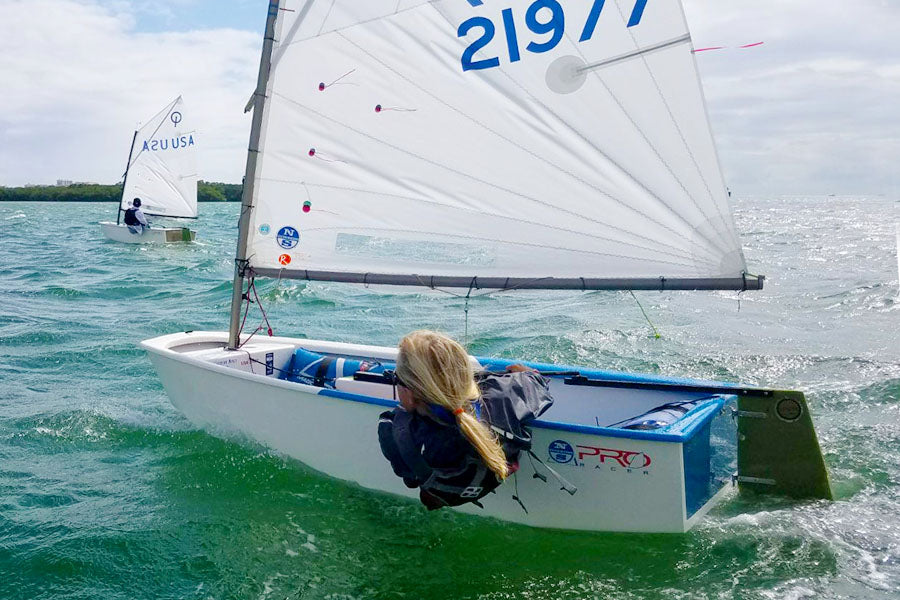
NORTH U LEADING EDGE OPTIMIST CLINIC
NORTH U LEADING EDGE OPTIMIST CLINIC
Optimist sailors in Miami, FL define their need for speed in two-day clinic with North Sails Experts and Coaches
In conjunction with the Southeast Dinghy Championships, North U hosted their inaugural Leading Edge Optimist Clinic at Key Biscayne Yacht Club to get sailors ready to take on the winter sailing season. Thirty-three Opti sailors from throughout the US, Puerto Rico, and the Virgin Islands participated in this first edition, which featured a curriculum spanning two days of on the water training and classroom sessions.
The sailors were challenged by a number of drills and races during the clinic, where boat handling, speed, and tactics all came into play. Miami delivered fresh conditions of sunshine and 10-15 knots of wind, a great platform for fun competition with new friends. North Sails Head Coach, Juan Carlos Romero, and Optimist expert Zeke Horowitz kept a close eye on the fleet to encourage participation and foster new experiences. Emphasis was placed on asking the sailors to think independently, as Juan explains,
“On the second day of the clinic, our main focus was to work with the sailors on their ability to develop a good strategy (game plan) and to help them make good tactical decisions. We incorporated two drills that forced our fleet to go through this thinking process, and then implement their tactical knowledge at its best to be able to execute their game plan.”
North Sails coaches reported the most effective drills were “Pick a Side” and “Long Line Starts”. In the Pick a Side drill, sailors learn to come up with a game plan and execute their decision to see how they end up at the top mark. The Long Line Starts drill gives sailors great practice in being able to tell how close they are to the start line by avoiding any potential line-sag.
North Sails designer, Mike Marshall was also on site, offering a fresh perspective on sail mechanics. Two seminars on “How Sails Work” gave sailors a deeper look at how the wind fills their sail to propel the boat forward, and how they can move the center of effort by fine-tuning their rigs with controls like sprit tension, boom vang, outhaul, and body movements to keep the boat flat. Lucas, who attended the clinic from Texas said:
“I usually sail on a lake. The chop and the breeze has been a nice challenge for me. The clinic has been great with all the help from the coaches. I learned a lot over the last two days.”
Sailors had the opportunity to try different sails over the two days, including the North Sails R1, R2, R4, and our latest design for the Optimist, the R5. Introduced this Summer, the R5 is made for specific weight ranges to increase point-ability. All sails in the R Series feature a radial cut.
Laura “Lulu,” who sails for Lauderdale Yacht Club tried the R2 product for the day. After three races in building breeze, she noticed when she put the bow down she was able to get speed while slowly pulling in her main to full trim.
“I was able to hold my lane, even when it was thin, and could get the extra point while my overall boat speed got faster.”
“The R1 has the right amount of power,” said Samara from New York. “It is super easy to get the extra point off the line at the start, where it’s really important to be fast.”
North Optimist sails are designed to produce the most power for their sailor, keeping them fast and able to maintain even the thinnest lanes. As sailors at the clinic tried out the R Series, we asked Mike about the benefits of radial vs. cross cut Opti sails.
“Radial sails have a more forgiving shape than conventional cross cut sails. They hold their shape better under different wind velocities. North’s cross-cut sails are not all that different from the R Series, but over time the cross cut will definitely break down more than the radial will. Are radials more sensitive to trim? Potentially, but that is the result of a design shape, not necessarily a sail’s construction.”
Amongst the many things addressed over the course of the two-day clinic, Juan wanted to make sure the sailors came away with something that would motivate them and help further their sailing careers,
“Put in time on the water. Don’t be lazy. Just get out there and spend as much time as you can on the water, in your boat. The clinic was an eyeopener for a lot of the kids who joined us, and it was nice to see the North designs bring success to those who used them over the course of the two days.”
Mike continued this sentiment from Juan,
“I encouraged them to try things on their own, don’t just do what you are told to do. Go out there and try to come up with solutions to your own questions you may have, or why you might not be going as well as someone next to you. Compare your sailing to someone else’s by finding the things they are doing that maybe you aren’t, and then try those things to see if it helps your performance.”
Special thanks to Agustin ‘Argy’ Resano, Brian Halloway, and Kristoffer Sarmiento who helped North Sails make this great event a success!
For more information on sails for the Optimist, or to speak with your local expert, visit our product page.
North Sails Optimist Tuning Guide
READ MORE
READ MORE



















